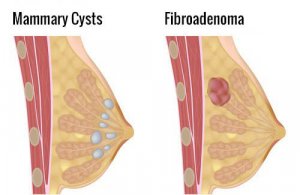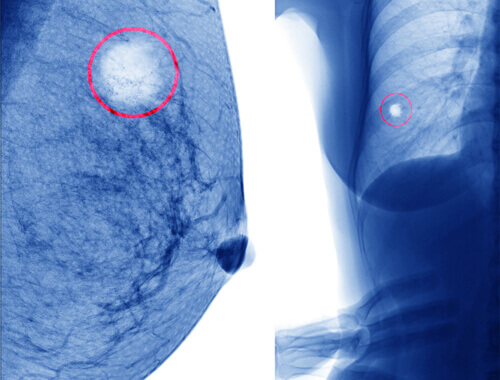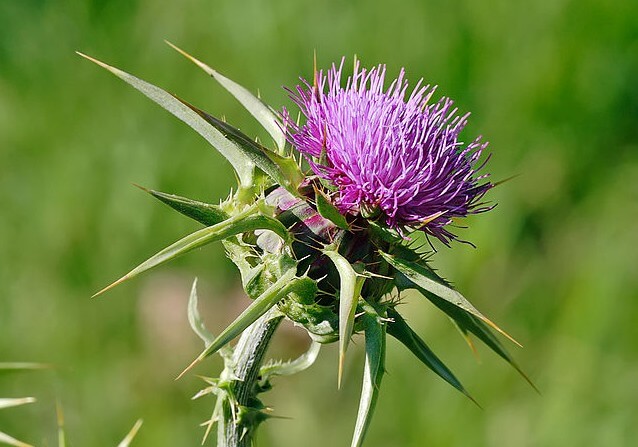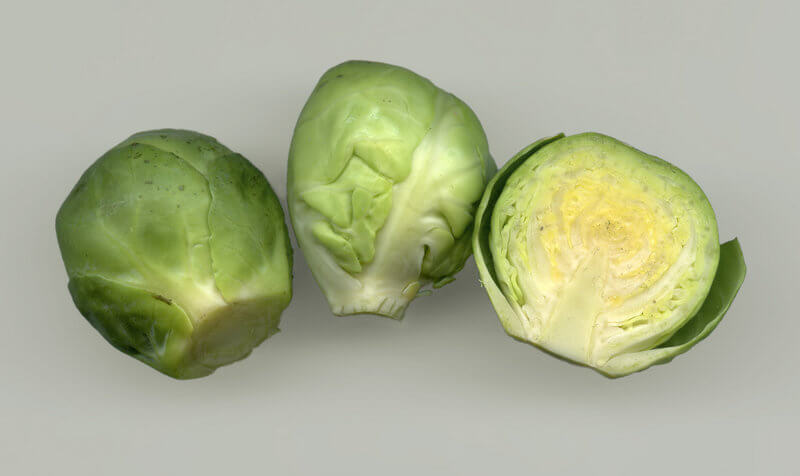How Do I Prevent Mammary Cysts?

Today, we’ll explain how to act and think properly in order to avoid having mammary cysts. Additionally, we’ll discuss some natural ways to treat them. Don’t miss it!
Having breast cancer is one of a lot of women’s greatest fears. However, a lump in your breast isn’t necessarily a sign that you have breast cancer. In this article, we’re going to look at some of the different types of cysts that exist, and what you should do if a self-exam or a medical exam from your doctor uncovers any growths or cysts.
Myths about mammary cysts
There are many urban legends circulating the internet and other places that claim that there is a direct connection between having mammary cysts and developing breast cancer.
However, this isn’t the case. What is true is that the development of mammary cysts can be managed, minimized, or, ideally, prevented altogether. So, there are several different behaviors and tips that should help you prevent mammary cysts as much as possible.
Although there’s no direct connection between having cysts in your breast and having breast cancer, several studies have shown that women who have never had children, women with irregular menstrual cycles, or women who have a history of breast cancer in their family often tend to develop cysts that can turn into breast cancer.
So, what is a mammary cyst?
A mammary cyst is a collection of liquid on the inside of the breast. Therefore, it’s a small sack, generally about the size of a chickpea or smaller, which usually contains liquid.
There’s no clear-cut way to tell when a mammary cyst is about to show up. They can appear in very young women and even children. Basically, they can start to show up around the time that breasts develop, generally from ages 10 to 12.
While the majority of mammary cysts are filled with liquid, there are also benign cysts that are more solid.

Fibroadenomas
There’s another type of cyst called a fibroadenoma. These tend to be symptomless and painless. Usually, you can discover them during a breast exam by feeling a small, hard, moveable lump in the breast.
It will generally feel either smooth or a bit rough when caused by a fibroadenoma with lobes when you touch it. It will move freely around the breast when you touch it. F
ortunately, they are also benign. Fibroadenomas occur when there is excessive growth of mammary tissue. Also, although they may be confused with the mammary cysts that we described above, they are different.
Fibroadenomas are more common before menopause. Although they can appear at any age, fibroadenomas tend to appear during puberty and in young adult women. This is because there is a relationship between their appearance and the hormonal changes that women go through at this age.
Upon discovering a one, the patient should keep an eye out for any changes in her breasts. Surgery is not always necessary. However, if you want to have them removed, they can be pierced to remove their contents or removed through surgery if they are hard.
We think you may also like to read this article: Types and Symptoms of Breast Cancer and Treatments
The causes of mammary cysts
Mammary cysts can have be caused by many different factors. First of all, due to the breast’s anatomy, it’s very common for the lobes in the breast to become blocked. This allows liquid to build up inside them. As a result, a mammary cyst will appear.
Also, it’s possible that they could be hereditary, although this is not common.
Whatever the type of cyst, the most common way they form is due to benign changes in the tissue of the mammary glands (fibrocystic breast). Mostly, this happens during the onset of menopause.
This is due not only to the hormonal imbalances that occur during this time, but also to fybrocystic changes(spontaneous changes in breast tissue that are both common and benign). This is very common, even in healthy breasts, and is believed to be a normal change.
It’s necessary to understand that mammary cysts happen because of hormone changes that are unique to every woman. Because of this, you need to do breast self-examinations regularly.
In fact, it’s very common that hormones will change in an instant. For this reason, you should try to give yourself a breast exam at the same time every month.
Diet and mammary cysts
Likewise, if your diet has a high concentration of xanthines (common in coffee, tea, chocolate, seafood, and sodas), it can make it more likely for cysts to appear.
Obesity is one risk factor that can cause the appearance of not only benign cysts, but also malignant ones. It can also cause women to lack breast milk.
However, people who haven’t had children are more likely to suffer from this than people who have. Another factor that can increase the likelihood of mammary cysts is menopause.
Having a diet lacking in fruits and vegetables increases the risk of cysts.
It’s also necessary for you to know that drugs, alcohol, and tobacco are factors that can increase the risk of breast cancer, not just mammary cysts.
There is a popular series of “steps” that claim to tell you how to cure cysts or avoid them, but they aren’t true. For example, one of the tips is to avoid mammograms because they can harm your breasts.
Other false claims include that “accidentally hurting your breast causes cancer”, “puncturing the cyst (generally done with a syringe to analyze the content) causes cysts to spread”, or “biopsies can cause cancer to spread”.
You might also hear that using contraceptives or implants can cause cysts or cancer to form.
Don’t pay much attention to these rumors, because, as you’ve already seen, the cause of these cysts and how they form are actually very different.
Habits and natural remedies to prevent the growth of cysts
We’re going to show you things that you should be doing to keep cysts from appearing, or, if you already have them, what you can do to keep them from growing or to avoid getting more.
The first is to take good preventative measures. It’s very important to check your breasts, dedicating time to get to know and feel your body so that you can tell if any new or unusual growths show up early. Feel your breasts at the same time every month so that you can detect a growth as soon as it appears.
There’s a lot that you can do to prevent the appearance of cysts, breast pain, and even breast cancer. An early diagnosis, a healthy diet, and getting to know your body can help your health immeasurably.
If, during your routine breast examination, you find any sort of lump, it’s advisable that you go to a doctor in order to do a simple biopsy. If it’s liquid or semisolid and there are no other signs, like blood, that indicate any negative side effects, in 98% of cases it is just a simple cyst.
These will not transform into cancer, and they aren’t dangerous. In every case, however, it’s important to figure out what’s inside of the cyst. Additionally, if you can, try to avoid the factors that are aggravating it or causing more to appear, which we’ll explain below.
Reduce the amount of fat and refined carbohydrates that you eat
Breast tissue is very sensitive to a diet rich in fat (especially saturated fats and trans fats) and carbohydrates since they can elevate estrogen levels. The overproduction of estrogen can cause painful breast tissue, the formation of cysts in many women, and an increased risk of breast cancer and other gynecological cancers.
For the same reason, you should reduce the amount of fat on your body if you are overweight.
Eat foods that can help you
You may also find this article interesting: The Relationship Between Eating Meat and Breast Cancer
Consuming natural fiber (especially from whole grains and fruits) is important for your body to eliminate excess estrogen. Also, cruciferous vegetables, such as broccoli, cabbage, Brussel sprouts, and turnips, contain a compound called indol-3-carbinol, which can reduce estrogen’s ability to adhere to breast tissue.
Try to eat at least 2 servings of this kind of vegetable a minimum of once a week. However, if it’s possible, you should try to eat them daily. You can also take extracts of broccoli or other cruciferous vegetables.
Additionally, derivatives of soy, such as tofu, miso, and tempeh, are often recommended for their vegetable phytoestregens, although there are studies for them and against them.
That’s why we recommend that you check out the arguments yourself to decide whether or not to eat soy. Regardless, you should avoid genetically modified soy, so look at the labels of the foods you buy.
A diet rich in whole foods and low in animal fats will definitely help you in your fight against cysts.
Eliminate milk products
We recommend that you eliminate all milk products from your diet, especially plain milk. Certainly, milk products are popular in today’s cuisine, but you should try to avoid them or at least consume less of them.
If you do eat them, make sure that they’re organic, because organic cows are not genetically modified or fed hormones. Try this for a month and observe your body. Afterward, we’re sure that you’ll see the difference.
Avoid caffeine and chocolate
You should stay away from foods that contain caffeine like coffee, tea, soft drinks, chocolate, and non-alcoholic beer. These products contain methylxanthines, which can overstimulate mammary tissue in some women.
It’s true that the decision to avoid chocolate can be difficult for a lot of people. So, if you have breast pain, cysts, etc., try to avoid it for at least one menstrual cycle and see what happens.
Eat more omega acids
As they are rich in omega 6 acids (gammolinolenic acid), evening primrose oil, and starflower oil can alleviate some breast issues and diminish inflammation in many women. Likewise, this is the case with omega 3.
This can be found in fish oil (though be wary of heavy metals), flaxseed oil, sesame oil, and nut oil. In fact, there are studies that show that consuming omega 3 acids can protect you against breast cancer. Moringa oil is also rich in omega 3, omega 6, and omega 9. Not to mention, it’s one of the best sources of natural antioxidants.
Take food supplements
Additionally, you should take vitamin and mineral supplements, especially vitamin E, vitamin A, coenzyme Q10, and selenium, as these antioxidants are very beneficial.
Notably, iodine can reduce estrogen’s capacity to adhere to receptors in the breast. Thus, it can help diminishe the pain in these areas. The best way to take iodine is through food.
For example, algae like wakame or kombu can easily give you iodine. However, we don’t recommend that women who have thyroid issues, especially hyperthyroidism, consume an excess of iodine.
Plant-based supplements for mammary cysts
- Various studies have shown that about 200 mg. of green tea extract (Camellia sinensis) a day helps to reduce the possibility of breast cancer and the risk of reappearance.
- Salvestrols can also help. For example, these are present in fruits like mandarin oranges, grapes, blueberries, and mulberries. For this reason, we recommend that you take a preparation at the necessary concentrations.
- Propolis, an extract from beehives, inhibits the activity of the enzyme aromatase. This can help slow down the production of excess estrogen.
- The black hoof mushroom (Phellinus linteus) stimulates the production of defensive cells, slowing the growth and formation of certain malignant cells. Not to mention, it reduces cell adhesion. Additionally, it inhibits the growth of both types of breast cancer cells. If you have cancer, you should consume it during and after a chemotherapy or radiotherapy treatment cycle. Also, you can combine it with other mushrooms including almond mushrooms (Agaricus blasei), turkey tail mushrooms (Coriolus versicolor), or reishi mushrooms (Ganoderma lucidum). We recommend that you take them on an empty stomach along with some kind of citrus juice.

- Milk thistle (Silybum marianum) can help the liver maintain health and good function. Ultimately, proper liver function will allow for good levels of estrogen. Milk thistle is also a good antioxidant. Additionally, it has antineoplastic effects (which prevent the development of tumorous cells).
Ditch the underwire bras
Underwire bras can block blood and lymph circulation in the chest, the vertebrae, and the back. If it is difficult or impossible for you to switch to bras without underwires, you should try to wear bras as little as you can.
Castor oil and clay
You can use a castor oil compress to diminish pain and inflammation in the breasts. You should use it for one hour three times a week, for two or three months. As a preventative measure, you can do it once a week.
Use a clay poultice or compress to help prevent pain and inflammation. It will also help eliminate cysts (we don’t recommend it for cancerous cysts, however, since it could cause them to spread).
First, leave it on until it has dried, and afterward, make sure to clean the breast well. Sometimes, you can sleep with a clay compress on. So that it doesn’t dry out, you can put some lettuce leaves on it. Then, you can wrap it or lay an old cotton rag over it.
As you can see, preventing mammary cysts or getting rid of them is within your reach. It only takes a little money and just a bit of vigilance regarding your own body. Keep this in mind and take care of yourself!
This text is provided for informational purposes only and does not replace consultation with a professional. If in doubt, consult your specialist.









